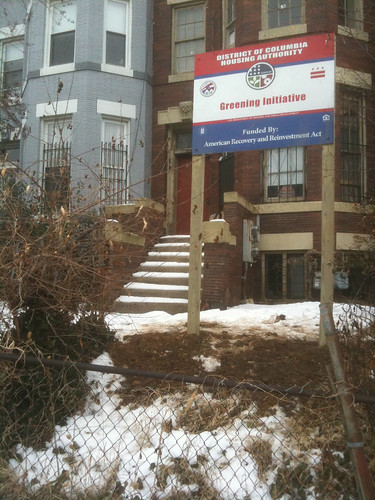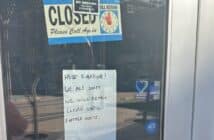After the recent post on seeing people working at one of the abandoned houses with the city’s Greening Initiative sign, I got an email address for Dena Michaelson at the District of Columbia Housing Authority, who sent me a press release about it. Basically, the authority got a grant from HUD to renovate 26 DCHA-owned abandoned houses around the city, some of which are abandoned, to be used as “scattered site” public housing.
Before you say “oh no, more public housing,” for the most part, the scattered site model does very well. There’s a lot of research on the benefits of individual houses in neighborhoods both for the residents and the neighborhoods. For example, check out this HUD study. There generally aren’t negative impacts either, like crime or dropping property values, as long as the sites are managed and tenants are screened well. It’s basically the same idea behind the generally successful HOPE VI program is doing, making mixed income housing, although in HOPE VI’s case it’s turning big buildings into smaller, more dispersed sites.
Plus there are already varying amounts of subsidized houses in the neighborhood, often done by non-profits. I’m checking to see how much the city runs. (See below for Update.)
This Examiner editorial says this model was tried before unsuccessfully, but it sounds like that was due a lack of emphasis under mayors Sharon Pratt Kelly, Marion Barry, and Anthony Williams rather than because it’s a bad plan.
And one could argue that if you want Columbia Heights to continue to be a diverse, mixed-income neighborhood, it’s better than having these abandoned houses go to developers and become expensive condos. Of course, that’s just one argument.
Your thoughts? Below is the relevant part of the press release from DCHA:
Scattered Sites (5 grants with very similar provisions for different groups of scattered sites)
HUD Funding: $1,927,406 Amount to be leveraged: $ 192,741 Total Project: $2,120,147
* Five grants provide funds for the gut rehabilitation of a total of 26 scattered site units throughout Washington DC.
* These units will be renewed from varying states of repair and disrepair, from structural repairs to the complete replacement of building systems. These units will go from being energy and water wasters to being models of resource and cost efficiency.
* All materials used in the rehabilitation and repairs will be as healthful, nontoxic, and sustainable-sourced as possible
——
UPDATE FROM DCHA AFTER ORIGINAL POST:
Scattered site public housing is an old program. At one point, DCHA owned more than 300 homes scattered throughout the city that housed public housing residents. It proved to be too disorganized and expensive to maintain all the properties at the level needed to provide safe and secure housing for the residents. In the ‘90s, DCHA started selling off the individual homes, giving first offers to existing residents in the homes, then to other public housing residents. Some were sold at market rate to get the funds to fix up others.
We are down to fewer than 60 scattered sites, now. We submitted a competitive grant request to HUD for ARRA funds, and received the 5 awards for a total of 26 houses. These are the ones being fixed up, and they will continue to house our residents. The remaining houses are either rented to public housing residents or being land-banked until we can find funds to fix them up for sale. Sales will be to low income families or at market rate, depending on our needs.
Note that “land-banked” means they’re owned by DCHA and unoccupied, which I previously called abandoned before I knew they were DCHA-owned.




